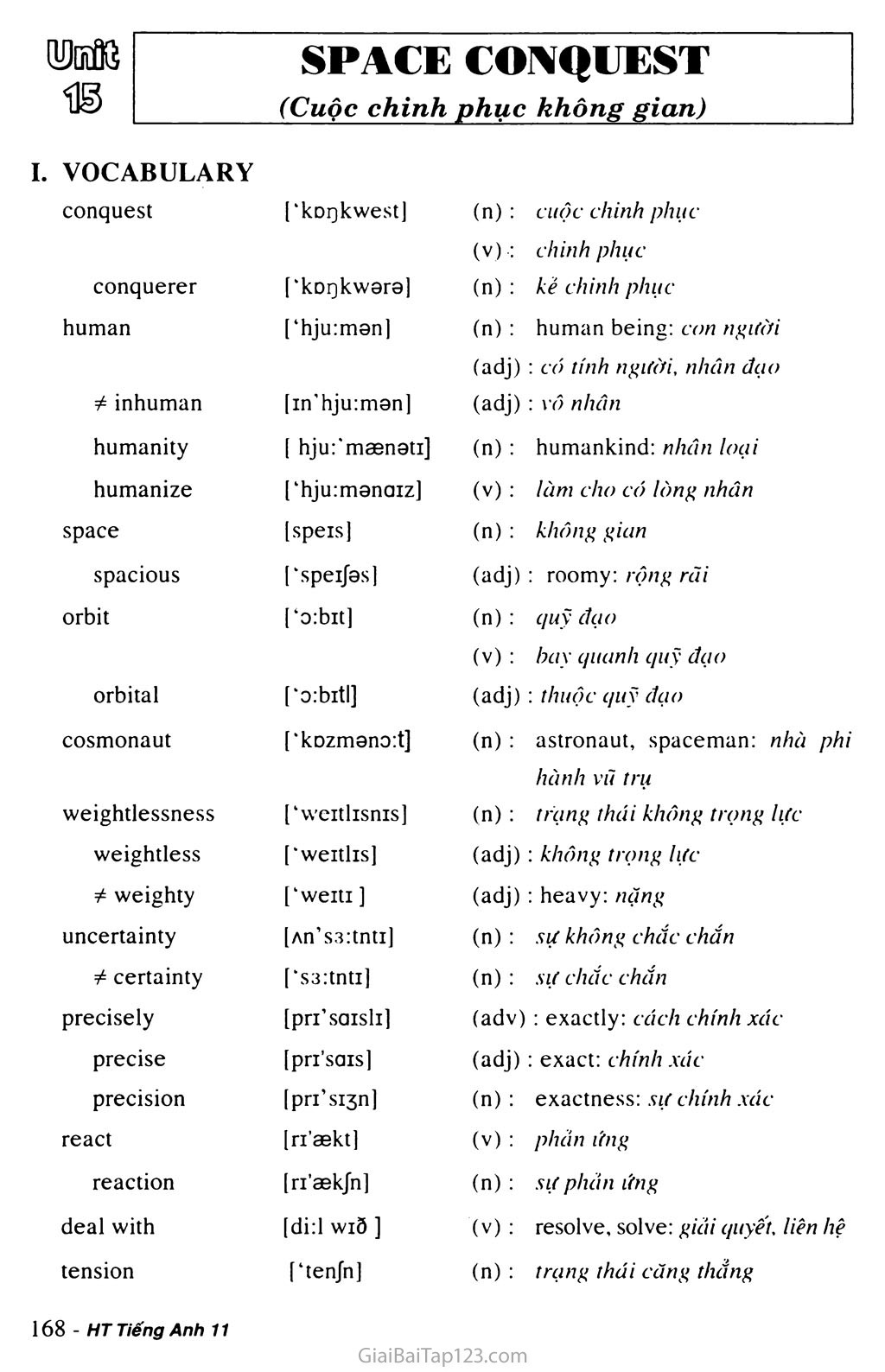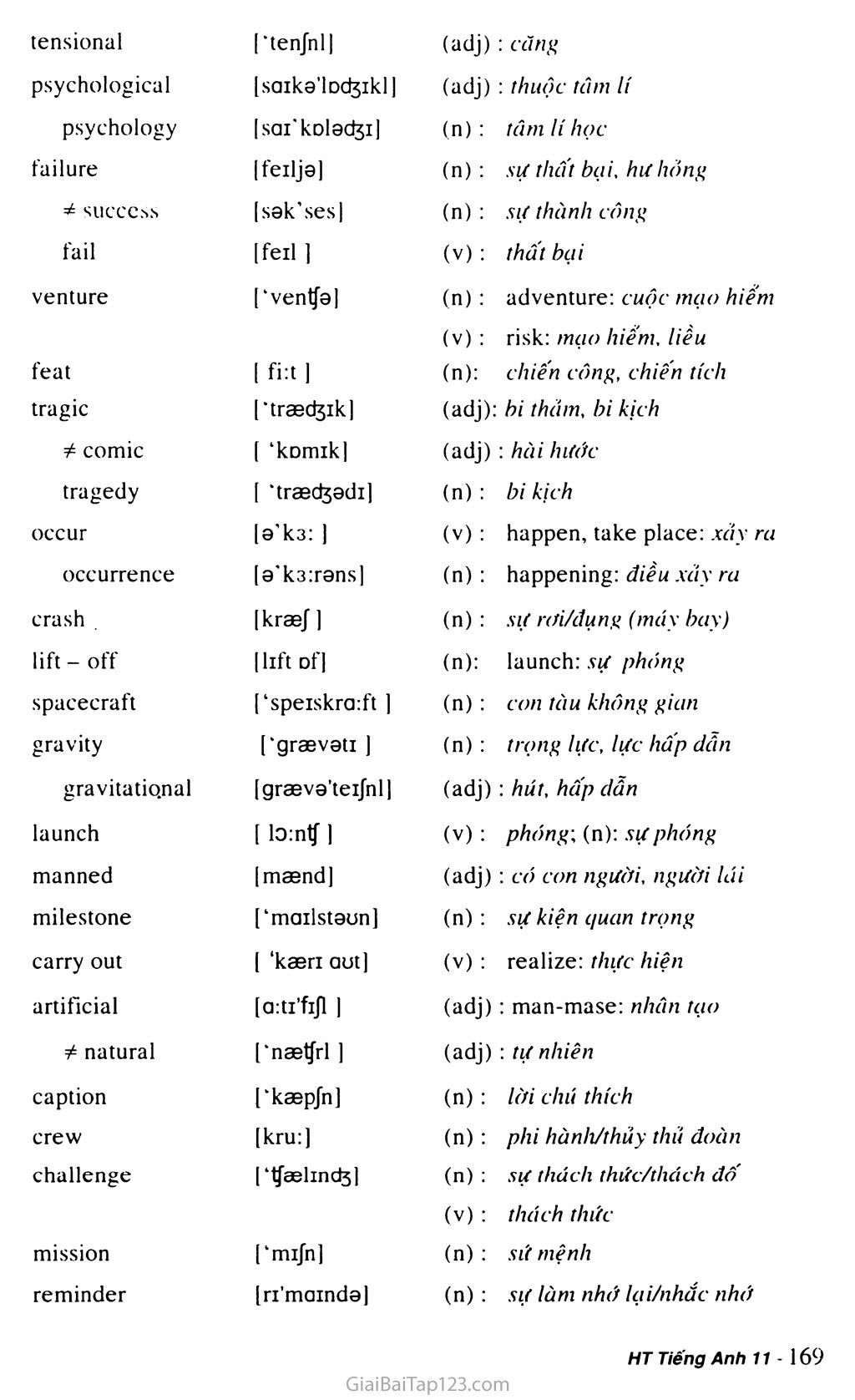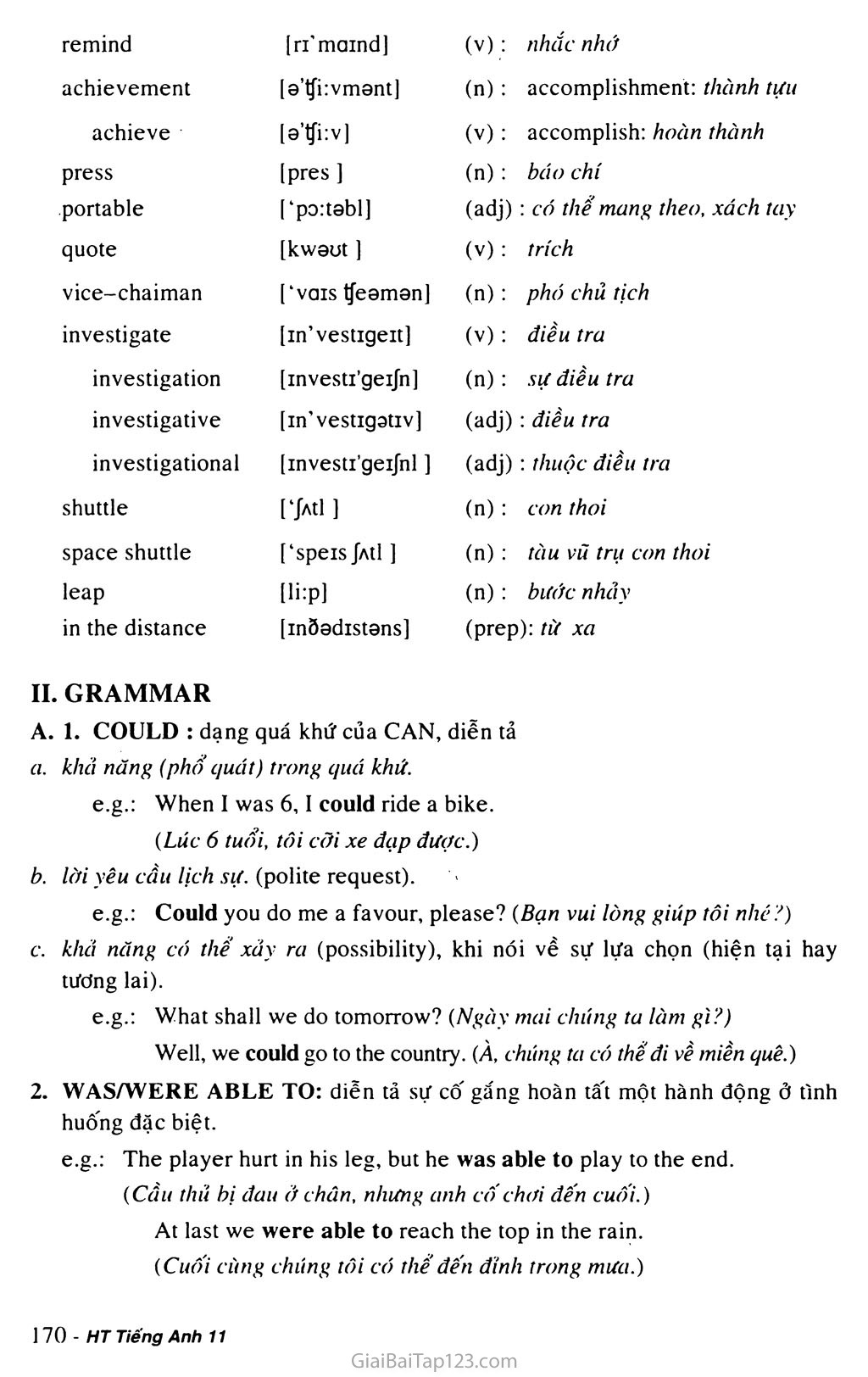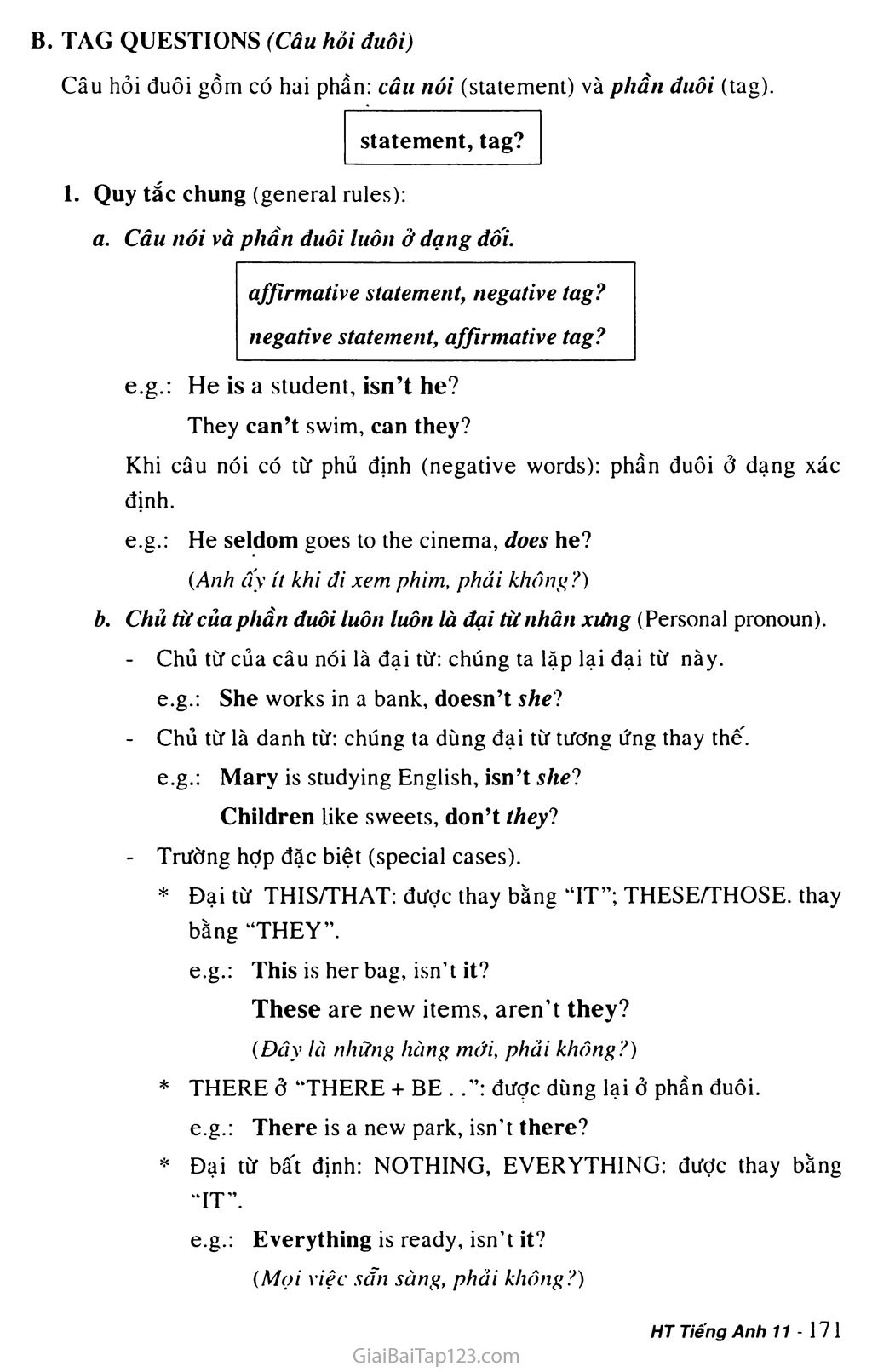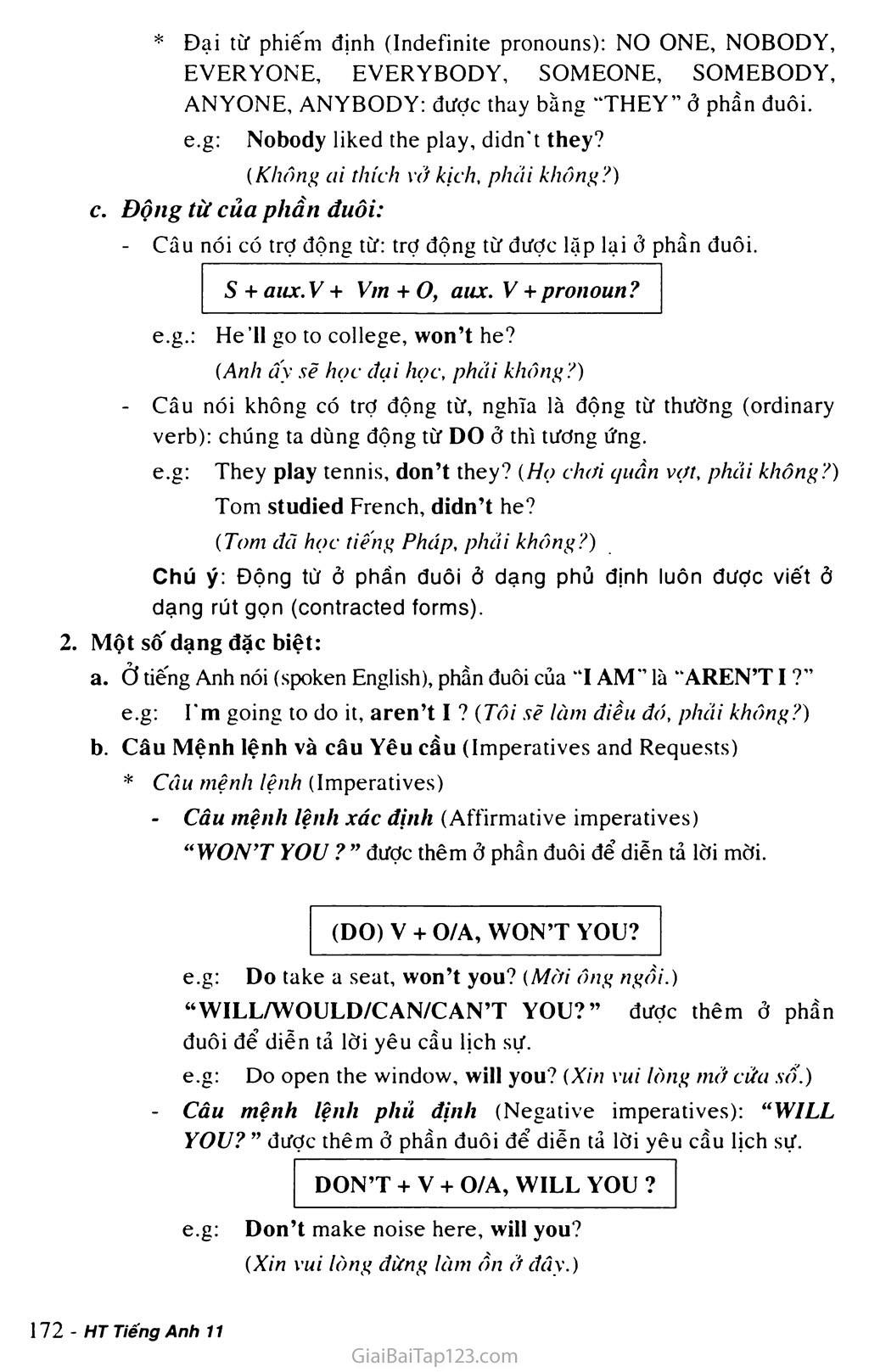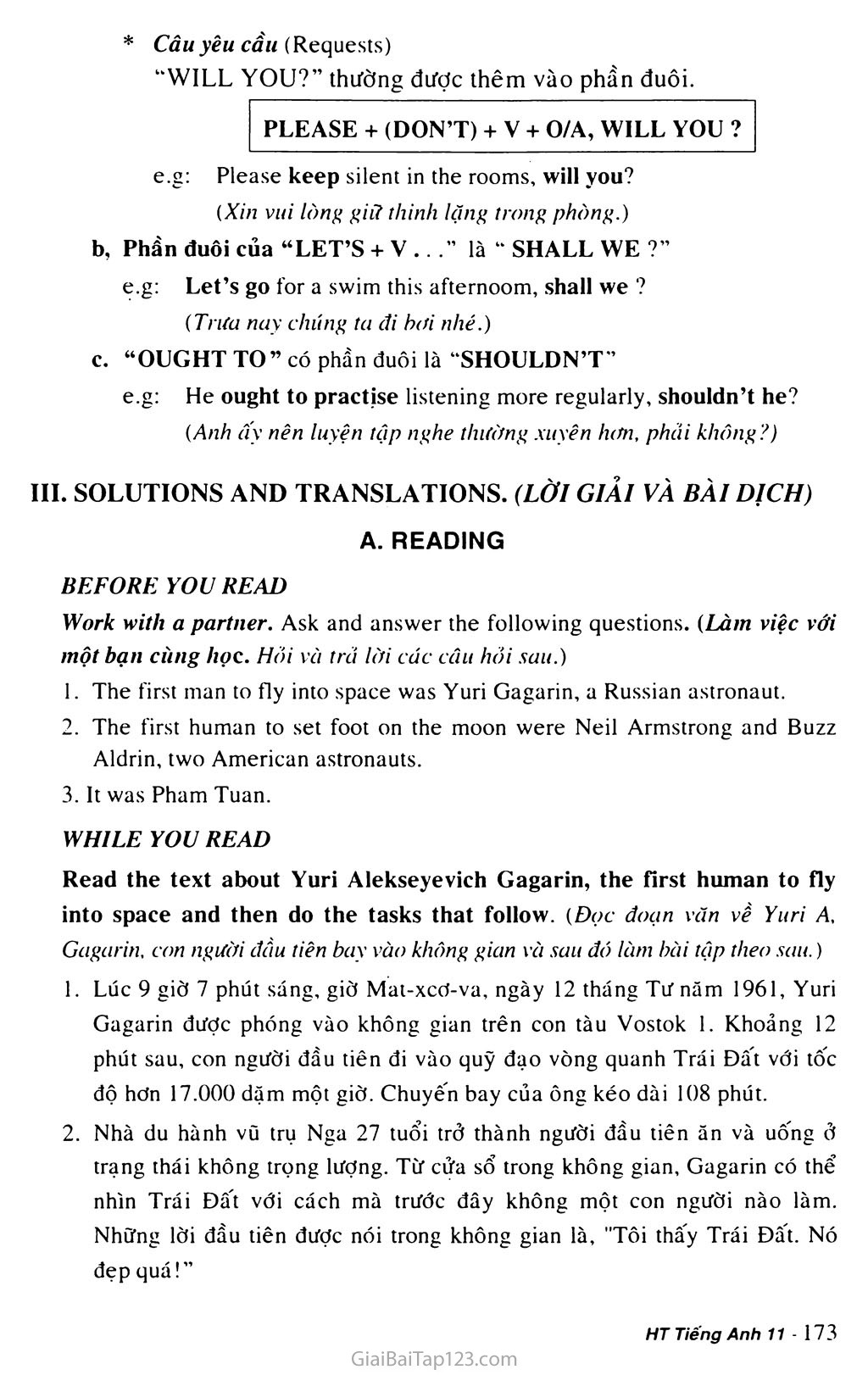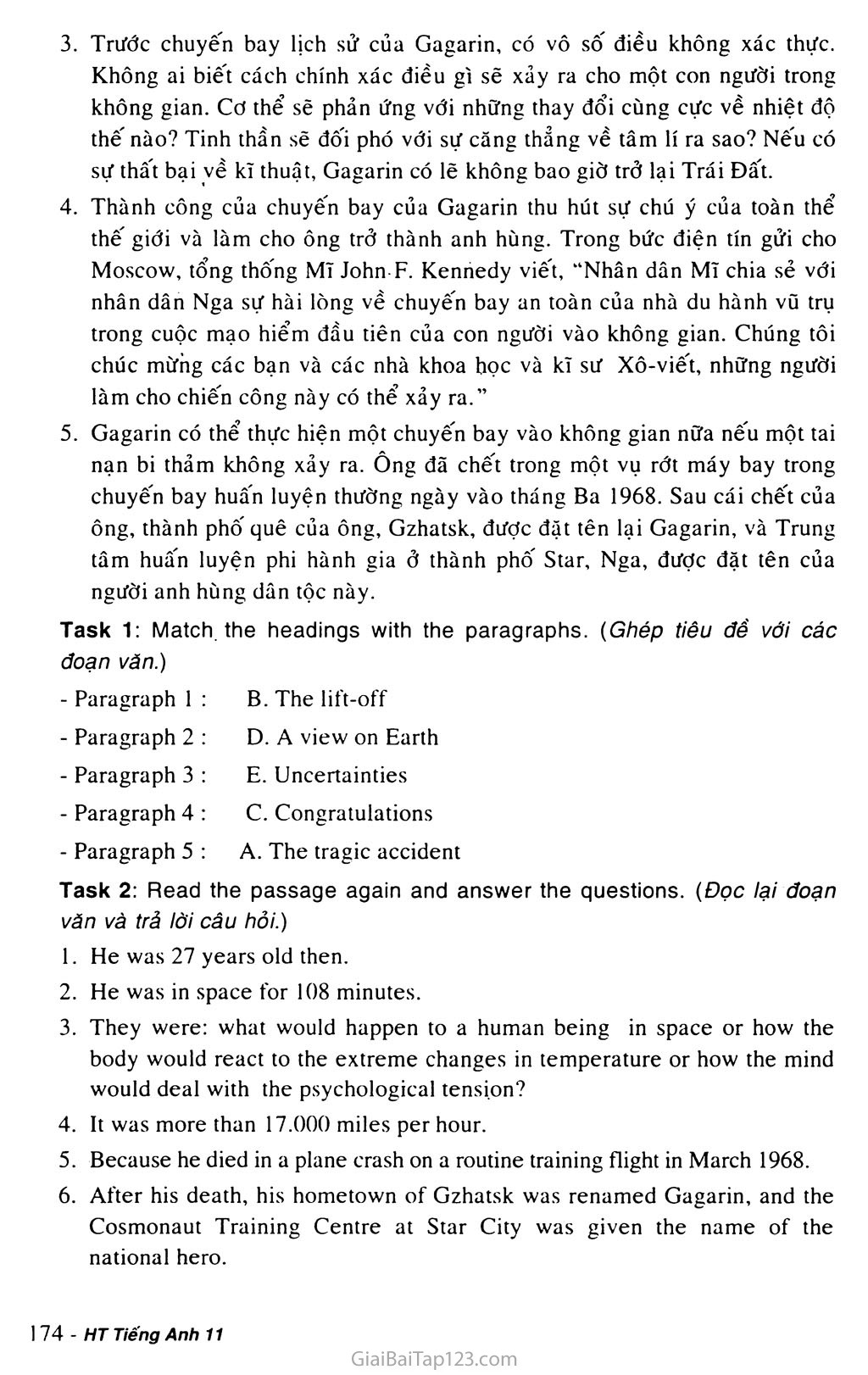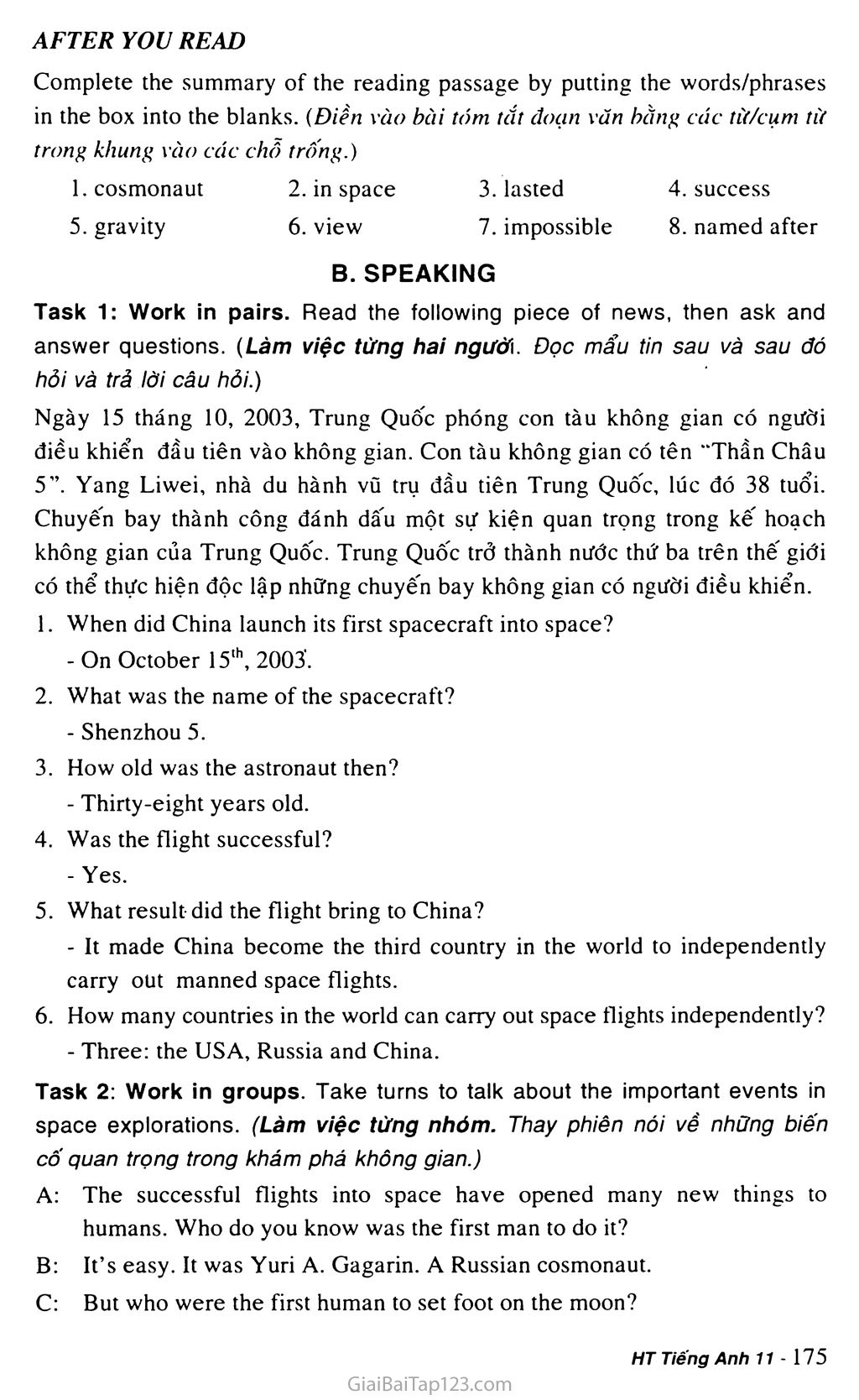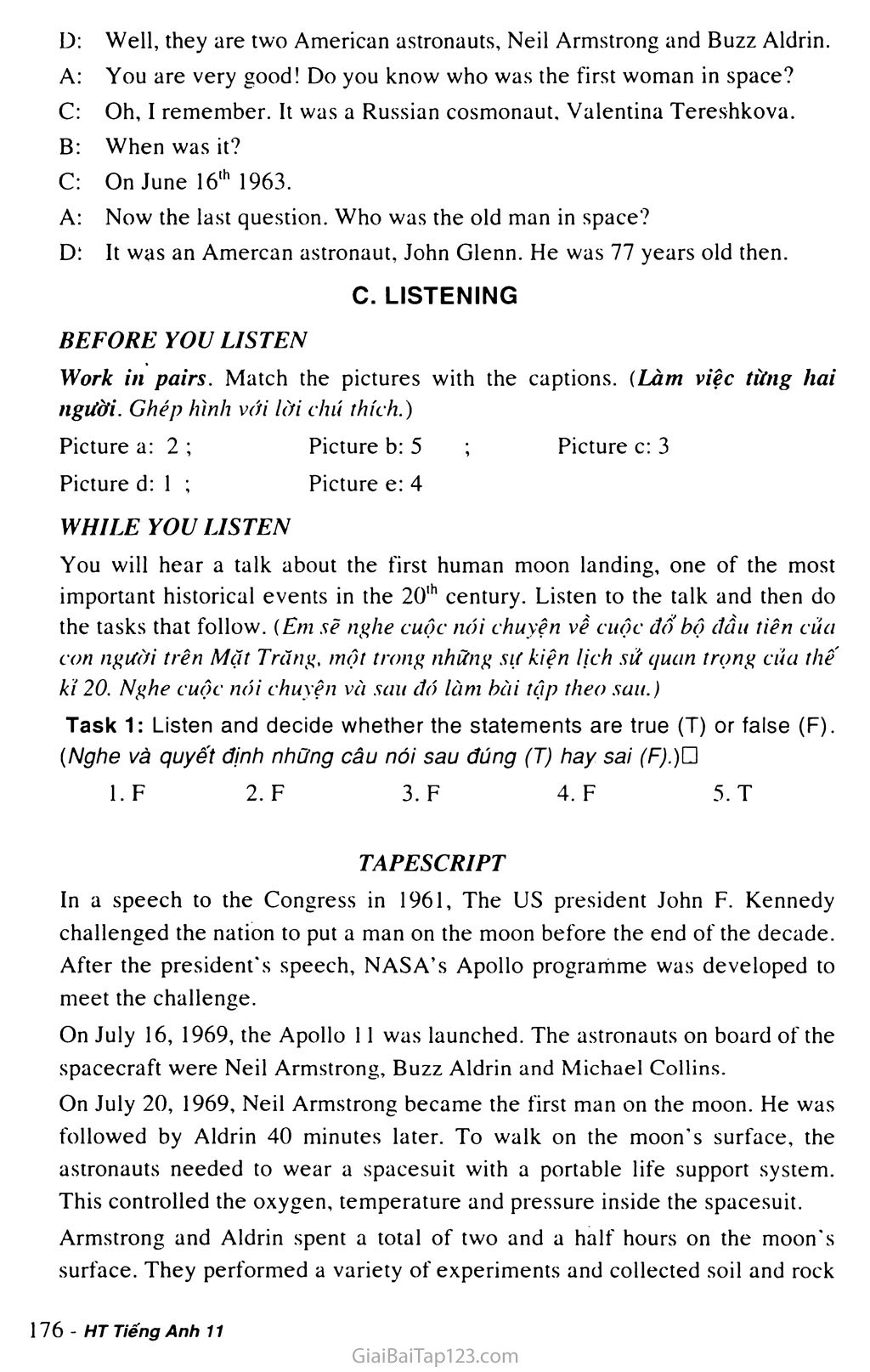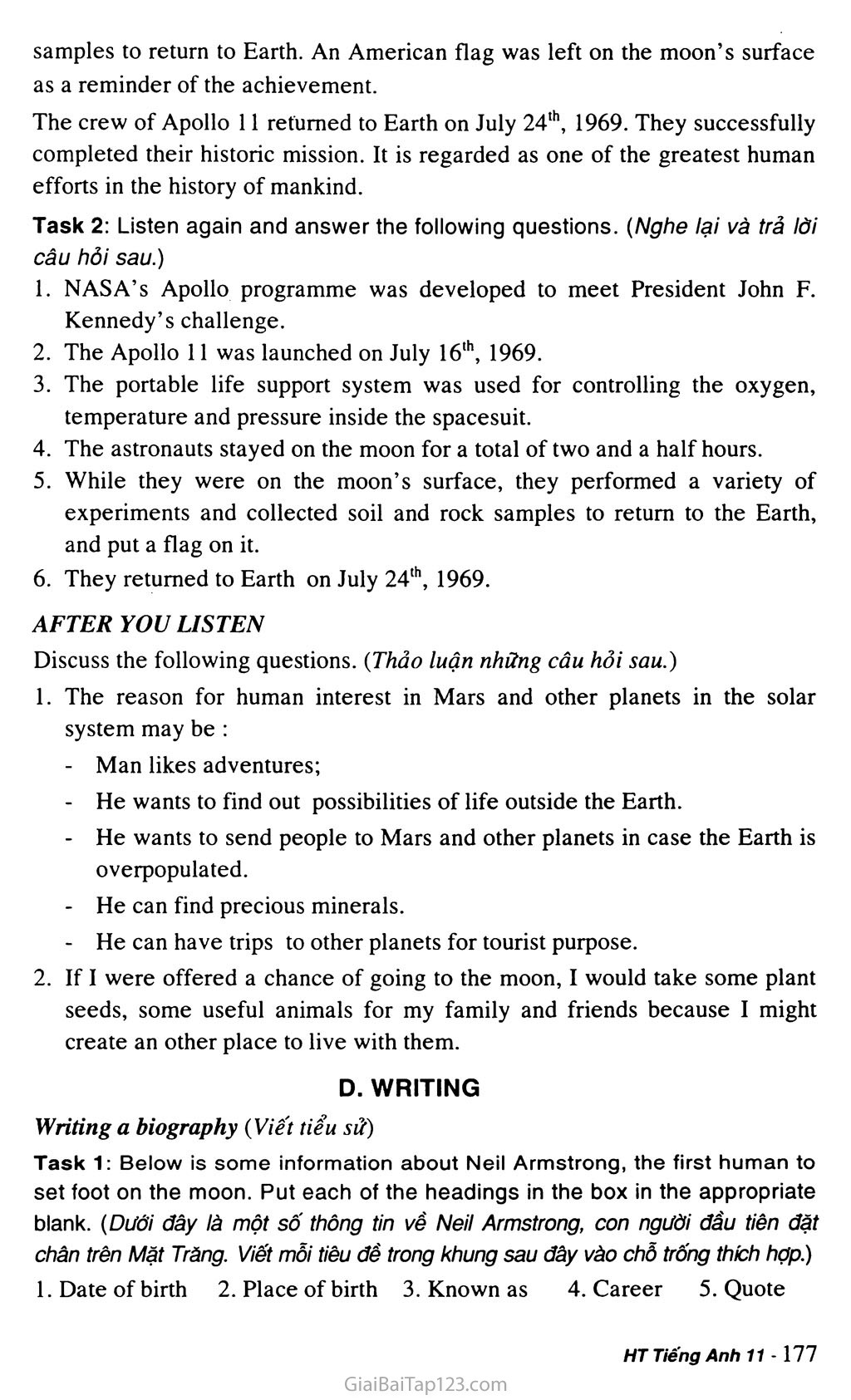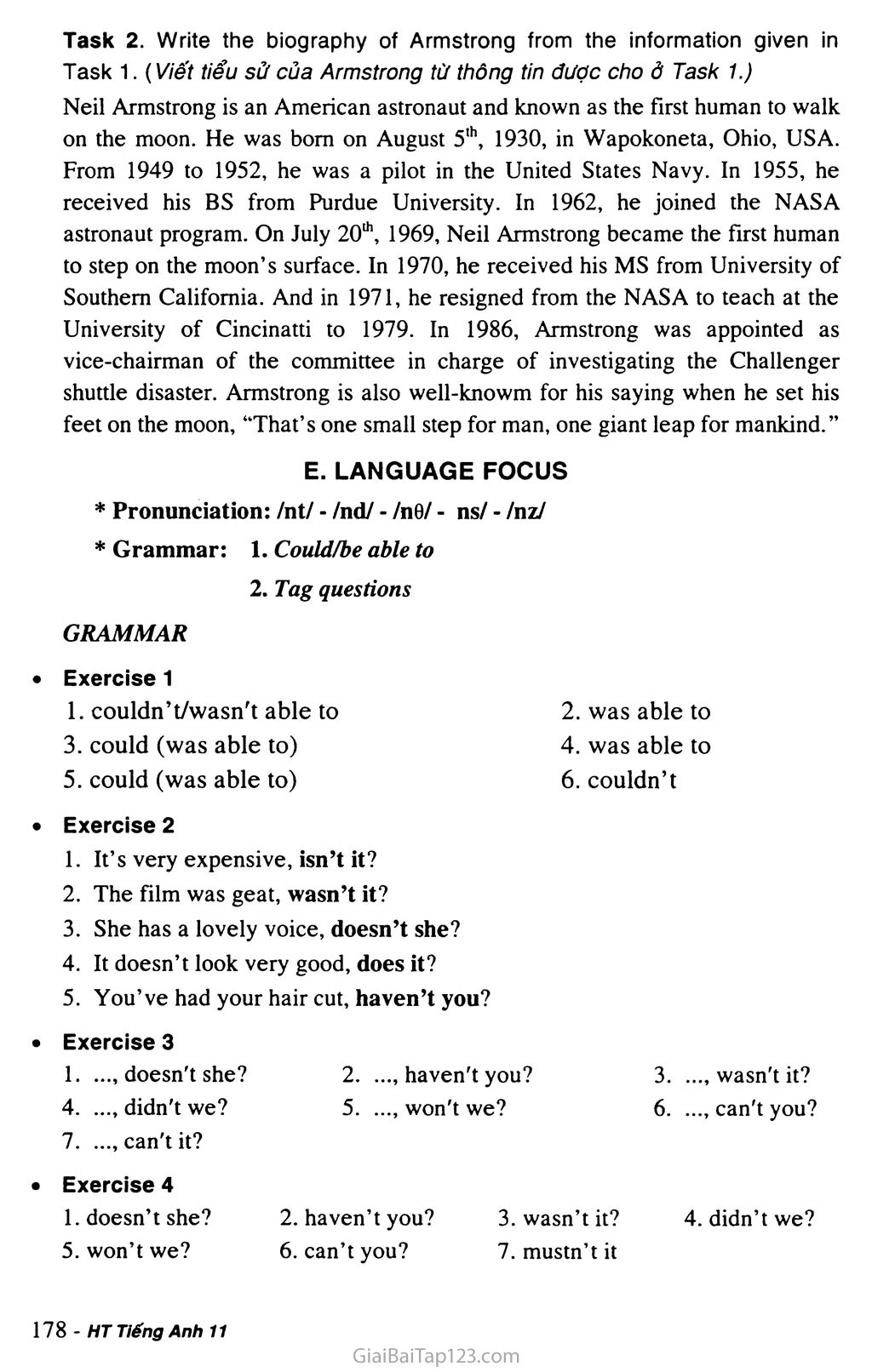Giải tiếng Anh lớp 11 Unit 15: SPACE CONQUEST
SPACE CONQUEST (Cuộc chinh phục không gian) I. VOCABULARY conquest [‘kDqkwest] (n) : (V) ■: cuộc chinh phục chinh phục conquerer [‘kDqkwara] (n) : kẻ chinh phục human [‘hju:man| (n): (adj) human being: con người : có tính người, nhân đạo inhuman |in’hju:man] (adj) : vô nhân humanity [ hjudmaenati] (n) : humankind: nhân loại humanize [‘hju:manaiz] (V): làm cho có lòng nhân space [speis] (n) : không giun spacious pspeijas] (adj) : roomy: rộ/ỉ£ rãi orbit [*o:bit] (n) : (V): quỹ dạo huy quunh quỹ đạo orbital [ ’o.’bitl] (adj) : thuộc quỹ dụo cosmonaut [’kDzmano:t] (n) : astronaut, spaceman: nhù phi hùnlĩ vũ trụ weightlessness [‘weitlisnis] (n) : trụng thúi không trọng lực weightless [’weitlis] (adj) : không trọng lực Ỷ weighty [‘weiti ] (adj) : heavy: nặng uncertainty [An’s3:tnti] (n) : sự không chắc chun Ạ certainty [‘S3:tnti] (n) : sự chác chun precisely [pri’saisli] (adv) : exactly: cách chính xác precise [pri’sais] (adj) : exact: chính xúc precision [pri’si3n] (n) : exactness: sự chính xúc react [ri’aekt] (V): phun lỉng reaction [ri’askjn] (n) : sự phun ứng deal with [did Wi9 ] (V): resolve, solve: giải quyết, liên hệ tension ptenjn] (n) : trụng thúi cũng thẳng tensional [ ’tenjnl I (adj) : căn# psychological I saika'lDdsikl J (adj) : thuộc tâm lí psychology Isai'kDlacfji] (n) : tâm lí học failure Ifeilja] (n) : sự thất bại, hư hỏng =£ success [sak’ses] (n) : sự thành công fail [fell I (V): thất bại venture [‘ventjal (n) : (V) : adventure: cuộc mạo hiểm risk: mạo hiểm, liều feat I fi:t ] (n): chiến công, chiến tích tragic I'traad3ik) (adj): bi thảm, bi kịch Í comic [ ‘kDmikl (adj) :hài hước tragedy I ' trascfssdil (n) : bi kịch occur [a’k3: I (V): happen, take place: xây ru occurrence |a'k3:rans] (n) : happening: điều xuy ru crash [kraej] (n) : sự rơỉ/đụng (múy buy) lift - off I lift Df] (n): launch: sự phóng spacecraft [‘speiskra:ft I (n): con tùu không giun gravity [‘graevati ] (n) : trọng lực, lực húp đun gravitatio.nal [graeva’teijnlj (adj) : hút, hup dẫn launch [ lotntf I (V): phóng-, (n): sự phóng manned (maend) (adj) : có con người, người lúi milestone [‘mailstaun] (n): sự kiện c/uun trọng carry out I ‘kaeri aut] (V): realize: thực hiện artificial [a:ti’fijl I (adj) : man-mase: nhân rạo / natural [‘naetfrl ] (adj) : tự nhiên caption [‘kaep/n] (n) : lời chú thích crew [kru:] (n): phi hùnh/thuy thử đoàn challenge [•tfaelindj] (n) : (V) : sự thách thức/thách đố thú ch thức mission I'mijn] (n) : sứ mệnh reminder Irimainda] (n) : sự lùm nhớ lụi/nhấc nhớ remind jri'maind] (V): nhắc nhớ achievement [e'tjuvmant] (n) : accomplishment: thành tựu achieve (V): accomplish: hoàn thành press [pres] (n) : báo chí portable l‘po:t8bl] (adj) : có thể mang theo, xách tay quote [kwaot ] (V): trích vice-chaiman [‘vais tfeaman] (n): phó chủ tịch investigate [in’vestigeit] (V): điều tra investigation [investi’geijn] (n): sự điều tra investigative [in’vestigotiv] (adj) : điều tra investigational [investi’geijnl ] (adj) : thuộc điều tra shuttle [‘/Atl ] (n) : con thoi space shuttle [‘speis jAtl ] (n): tàu vũ trụ con thoi leap [li:p] (n): bước nhảy in the distance [inbsdistens] (prep): tit xa GRAMMAR A. 1. COULD : dạng quá khứ của CAN, diễn tả khả năng (phổ quát) trong quá khứ. e.g.: When I was 6,1 could ride a bike. (Lúc 6 tuổi, tôi cỡi xe đạp được.) lời yêu cầu lịch sự. (polite request). e.g.: Could you do me a favour, please? (Bạn vui lòng giúp tôi nhé?) khả năng có thể xay ra (possibility), khi nói về sự lựa chọn (hiện tại hay tương lai). e.g.: What shall we do tomorrow? (Ngày mai chúng ta làm gì?) Well, we could go to the country. (À, chúng ta có thể đi về miền quê.) WAS/WERE ABLE TO: diễn tả sự cố’ gắng hoàn tất một hành động ở tình huống đặc biệt. e.g.: The player hurt in his leg, but he was able to play to the end. (Cẩu thủ hi đau ở chăn, nhưng anh cố chơi đến cuô'i.) At last we were able to reach the top in the rain. (Cuối cùng chúng tôi có thế’đến đỉnh trong mưa.) B. TAG QUESTIONS (Câu hỏi đuôi) Câu hỏi đuôi gồm có hai phần: câu nói (statement) và phần đuôi (tag), statement, tag? 1. Quy tắc chung (general rules): Câu nói và phần đuôi luôn ở dạng đôi. affirmative statement, negative tag? negative statement, affirmative tag? e.g.: He is a student, isn’t he? They can’t swim, can they? Khi câu nói có từ phủ định (negative words): phần đuôi ở dạng xác định. e.g.: He seldom goes to the cinema, does he? (Anh ấy ít khi di xem phim, phủi không?) Chủ từ của phần đuôi luôn luôn là đại từ nhân xứng (Personal pronoun). Chủ từ của câu nói là đại từ: chúng ta lặp lại đại từ này. e.g.: She works in a bank, doesn’t she? Chủ từ là danh từ: chúng ta dùng đại từ tương ứng thay thế. e.g.: Mary is studying English, isn’t she? Children like sweets, don’t they? Trường hợp đặc biệt (special cases). Đại từ THIS/THAT: được thay bằng “IT”; THESE/THOSE. thay bằng “THEY”. e.g.: This is her bag, isn’t it? These are new items, aren’t they? (Đây là những hàng mới, phai không?) THERE ở “THERE + BE . .”: được dùng lại ở phần đuôi, e.g.: There is a new park, isn't there? Đại từ bất định: NOTHING, EVERYTHING: được thay bằng "IT”. e.g.: Everything is ready, isn’t it? (Mọi việc sẵn sàng, phải không?) * Đại từ phiếm định (Indefinite pronouns): NO ONE, NOBODY, EVERYONE, EVERYBODY, SOMEONE, SOMEBODY, ANYONE, ANYBODY: được thay bằng “THEY” ở phần đuôi, e.g: Nobody liked the play, didn't they? (Không ai thích vở kịch, phải không?) Động từ của phần đuôi: Câu nói có trỢ động từ: trợ động từ được lặp lại ở phần đuôi. s + aux.V + Vm + o, aux. V + pronoun? e.g.: He’ll go to college, won’t he? (Anh ấy sẽ học dụi học, phải không?) Câu nói không có trợ động từ, nghĩa là động từ thường (ordinary verb): chúng ta dùng động từ DO ở thì tương ứng. e.g: They play tennis, don’t they? (Họ chơi quần vợt, phải không?) Tom studied French, didn’t he? (Tom đã học tiếng Pháp, phải không?) Chú ý: Động từ ở phần đuôi ở dạng phủ định luôn được viết ở dạng rút gọn (contracted forms). Một số dạng đặc biệt: Ớ tiếng Anh nói (spoken English), phần đuôi của “I AM” là "AREN’T I ?” e.g: I'm going to do it, aren’t I ? (Tôi sẽ làm điều đó, phải không?) Câu Mệnh lệnh và câu Yêu cầu (Imperatives and Requests) * Câu mệnh lệnh (Imperatives) - Câu mệnh lệnh xác định (Affirmative imperatives) “WON’T YOU ?” được thêm ở phần đuôi để diễn tả lời mời. (DO) V + O/A, WON’T YOU? e.g: Do take a seat, won’t you? (Mời ông ngồi.) “WILL/WOULD/CAN/CAN’T YOU?” được thêm ở phần đuôi để diễn tả lời yêu cầu lịch sự. e.g: Do open the window, will you? (Xin vui lòng mớ cửa sổ.) - Câu mệnh lệnh phủ định (Negative imperatives): “WILL YOU? ” được thêm ở phần đuôi để diễn tả lời yêu cầu lịch sự. DON’T + V + O/A, WILL YOU ? e.g: Don’t make noise here, will you? (Xin vui lòng dừng làm ồn ở đây.) * Câu yêu cầu (Requests) “WILL YOU?” thường được thêm vào phần đuôi. PLEASE + (DON’T) + V + O/A, WILL YOU ? e.g: Please keep silent in the rooms, will you? (Xin vui lòng giữ thinh lặng trong phòng.) Phần đuôi của “LET’S + V .. là “ SHALL WE ?” e.g: Let’s go for a swim this afternoom, shall we ? (Trưa nay chúng ta đi hơi nhé.) “OUGHT TO” có phần đuôi là “SHOULDN’T” e.g: He ought to practise listening more regularly, shouldn’t he? (Anh ấy nên luyện tập nghe thường xuyên h(fn, phải không?) III. SOLUTIONS AND TRANSLATIONS. (LỜI GIẢI VÀ BÀI DỊCH) A. READING BEFORE YOU READ Work with a partner. Ask and answer the following questions. (Làm việc với một bạn cùng học. Hoi và trả lời các câu hỏi sau.) The first man to fly into space was Yuri Gagarin, a Russian astronaut. The first human to set foot on the moon were Neil Armstrong and Buzz Aldrin, two American astronauts. It was Pham Tuan. WHILE YOU READ Read the text about Yuri Alekseyevich Gagarin, the first human to fly into space and then do the tasks that follow. (Đọc đoạn văn về Yuri A, Gagarin, con người dầu tiên bay vào không gian và sau dó lăm hài tập theo sau.) Lúc 9 giờ 7 phút sáng, giờ Mat-xcơ-va, ngày 12 tháng Tư năm 1961, Yuri Gagarin được phóng vào không gian trên con tàu Vostok 1. Khoảng 12 phút sau, con người đầu tiên đi vào quỹ đạo vòng quanh Trái Đất với tốc độ hơn 17.000 dặm một giờ. Chuyến bay của ông kéo dài 108 phút. Nhà du hành vũ trụ Nga 27 tuổi trở thành người đầu tiên ăn và uống ở trạng thái không trọng lượng. Từ cửa sổ trong không gian, Gagarin có thể nhìn Trái Đất với cách mà trước đây không một con người nào làm. Những lời đầu tiên được nói trong không gian là, "Tôi thây Trái Đât. Nó đẹp quá!” Trước chuyến bay lịch sử của Gagarin, có vô số điều không xác thực. Không ai biết cách chính xác điều gì sẽ xảy ra cho một con người trong không gian. Cơ thể sẽ phản ứng với những thay đổi cùng cực về nhiệt độ thê nào? Tinh thần sẽ đôi phó với sự căng thẳng về tâm lí ra sao? Nếu có sự that bại về kĩ thuật, Gagarin có lẽ không bao giờ trở lại Trái Đất. Thành công của chuyến bay của Gagarin thu hút sự chú ý của toàn thể thê giới và làm cho ông trở thành anh hùng. Trong bức điện tín gửi cho Moscow, tổng thông Mĩ John F. Kennedy viết, “Nhân dân Mĩ chia sẻ với nhân dân Nga sự hài lòng về chuyến bay an toàn của nhà du hành vũ trụ trong cuộc mạo hiểm đầu tiên của con người vào không gian. Chúng tôi chúc mừng các bạn và các nhà khoa học và kĩ sư Xô-viết, những người làm cho chiến công này có thể xảy ra.” Gagarin có thể thực hiện một chuyến bay vào không gian nữa nếu một tai nạn bi thảm không xảy ra. Ồng đã chết trong một vụ rớt máy bay trong chuyến bay huân luyện thường ngày vào tháng Ba 1968. Sau cái chết của ông, thành phố quê của ông, Gzhatsk, được đặt tên lại Gagarin, và Trung tâm huân luyện phi hành gia ở thành phô' Star, Nga, được đặt tên của người anh hùng dân tộc này. Task 1: Match the headings with the paragraphs. (Ghép tiêu đề với các đoạn văn.) Paragraph l : Paragraph 2: Paragraph 3 : Paragraph 4 : Paragraph 5 : B. The lift-off A view on Earth Uncertainties Congratulations A. The tragic accident Task 2: Read the passage again and answer the questions. (Đọc lại đoạn văn và trả lời câu hỏi.) He was 27 years old then. He was in space for 108 minutes. They were: what would happen to a human being in space or how the body would react to the extreme changes in temperature or how the mind would deal with the psychological tension? It was more than 17.000 miles per hour. Because he died in a plane crash on a routine training flight in March 1968. After his death, his hometown of Gzhatsk was renamed Gagarin, and the Cosmonaut Training Centre at Star City was given the name of the national hero. AFTER YOU READ Complete the summary of the reading passage by putting the words/phrases in the box into the blanks. (Điền vào bùi tóm tắt đoạn văn bằng các từ/cụm từ trong khung vào các chỗ trông.') cosmonaut 2. in space 3. lasted 4. success 5. gravity 6. view 7. impossible 8. named after B. SPEAKING Task 1: Work in pairs. Read the following piece of news, then ask and answer questions. (Làm việc từng hai ngườ\. Dọc mẩu tin sau và sau đó hỏi và trả lời câu hỏi.) Ngày 15 tháng 10, 2003, Trung Quốc phóng con tàu không gian có người điều khiển đầu tiên vào không gian. Con tàu không gian có tên "Thần Châu 5”. Yang Liwei, nhà du hành vũ trụ đầu tiên Trung Quốc, lúc đó 38 tuổi. Chuyến bay thành công đánh dấu một sự kiện quan trọng trong kế hoạch không gian của Trung Quốc. Trung Quốc trở thành nước thứ ba trên thế giới có thể thực hiện độc lập những chuyến bay không gian có người điều khiển. When did China launch its first spacecraft into space? On October 15th, 2003'. What was the name of the spacecraft? Shenzhou 5. How old was the astronaut then? Thirty-eight years old. Was the flight successful? Yes. What result did the flight bring to China? It made China become the third country in the world to independently carry out manned space flights. How many countries in the world can carry out space flights independently? Three: the USA, Russia and China. Task 2: Work in groups. Take turns to talk about the important events in space explorations. (Làm việc từng nhóm. Thay phiên nói về những biến cố quan trọng trong khám phá không gian.) A: The successful flights into space have opened many new things to humans. Who do you know was the first man to do it? B: It’s easy. It was Yuri A. Gagarin. A Russian cosmonaut. C: But who were the first human to set foot on the moon? D: Well, they are two American astronauts, Neil Armstrong and Buzz Aldrin. A: You are very good! Do you know who was the first woman in space? C: Oh, I remember. It was a Russian cosmonaut, Valentina Tereshkova. B: When was it? C: On June 16th 1963. A: Now the last question. Who was the old man in space? D: It was an Amercan astronaut. John Glenn. He was 77 years old then. c. LISTENING BEFORE YOU LISTEN Work in pairs. Match the pictures with the captions. (Làm việc từng hai người. Ghép hình với lời chú thích.) Picture a: 2 ; Picture b: 5 ; Picture c: 3 Picture d: 1 ; Picture e: 4 WHILE YOU LISTEN You will hear a talk about the first human moon landing, one of the most important historical events in the 20Ih century. Listen to the talk and then do the tasks that follow. (Em sẽ nghe cuộc nói chuyện về cuộc đổ bộ (lầu tiên cua con người trên Mặt Trăng, một trong những sự kiện lịch sử quan trọng cua thê kí 20. Nghe cuộc nói chuyện và sau (ló làm bài tập theo sau.) Task 1: Listen and decide whether the statements are true (T) or false (F). (Nghe và quyết định nhũng câu nói sau đúng (T) hay sai (F).)O 1.F 2. F 3.F 4. F 5. T TAPESCRIPT In a speech to the Congress in 1961, The US president John F. Kennedy challenged the nation to put a man on the moon before the end of the decade. After the president's speech, NASA’s Apollo programme was developed to meet the challenge. On July 16, 1969, the Apollo 11 was launched. The astronauts on board of the spacecraft were Neil Armstrong, Buzz Aldrin and Michael Collins. On July 20, 1969, Neil Armstrong became the first man on the moon. He was followed by Aldrin 40 minutes later. To walk on the moon's surface, the astronauts needed to wear a spacesuit with a portable life support system. This controlled the oxygen, temperature and pressure inside the spacesuit. Armstrong and Aldrin spent a total of two and a half hours on the moon's surface. They performed a variety of experiments and collected soil and rock samples to return to Earth. An American flag was left on the moon’s surface as a reminder of the achievement. The crew of Apollo 11 returned to Earth on July 24Ih, 1969. They successfully completed their historic mission. It is regarded as one of the greatest human efforts in the history of mankind. Task 2: Listen again and answer the following questions. (Nghe lại và trả lời câu hỏi sau.) NASA’s Apollo programme was developed to meet President John F. Kennedy’s challenge. The Apollo 11 was launched on July 16th, 1969. The portable life support system was used for controlling the oxygen, temperature and pressure inside the spacesuit. The astronauts stayed on the moon for a total of two and a half hours. While they were on the moon’s surface, they performed a variety of experiments and collected soil and rock samples to return to the Earth, and put a flag on it. They returned to Earth on July 24th, 1969. AFTER YOU LISTEN Discuss the following questions. (Thảo luận những câu hỏi sau.) The reason for human interest in Mars and other planets in the solar system may be : Man likes adventures; He wants to find out possibilities of life outside the Earth. He wants to send people to Mars and other planets in case the Earth is overpopulated. He can find precious minerals. He can have trips to other planets for tourist purpose. If I were offered a chance of going to the moon, I would take some plant seeds, some useful animals for my family and friends because I might create an other place to live with them. D. WRITING Writing a biography (Viết tiểu sử) Task 1: Below is some information about Neil Armstrong, the first human to set foot on the moon. Put each of the headings in the box in the appropriate blank. (Dưởi đây là một số thông tin về Neil Armstrong, con người đầu tiên đặt chân trên Mặt Trăng. Viết mỗi tiêu đề trong khung sau đây vào chỗ trống thích hợp.) 1. Date of birth 2. Place of birth 3. Known as 4. Career 5. Quote Task 2. Write the biography of Armstrong from the information given in Task 1. (Viết tiểu sử của Armstrong từ thông tin được cho ở Task 1.) GRAMMAR Neil Armstrong is an American astronaut and known as the first human to walk on the moon. He was bom on August 5th, 1930, in Wapokoneta, Ohio, USA. From 1949 to 1952, he was a pilot in the United States Navy. In 1955, he received his BS from Purdue University. In 1962, he joined the NASA astronaut program. On July 20th, 1969, Neil Armstrong became the first human to step on the moon’s surface. In 1970, he received his MS from University of Southern California. And in 1971, he resigned from the NASA to teach at the University of Cincinatti to 1979. In 1986, Armstrong was appointed as vice-chairman of the committee in charge of investigating the Challenger shuttle disaster. Armstrong is also well-knowm for his saying when he set his feet on the moon, ‘*That’s one small step for man, one giant leap for mankind.” E. LANGUAGE FOCUS Pronunciation: /nt/ - /nd/ - /n0/ - ns/ - /nz/ Grammar: 1. Could/be able to 2. Tag questions • Exercise 1 1. couldn’t/wasn't able to 2. was able to 3. could (was able to) 4. was able to 5. could (was able to) Exercise 2 It’s very expensive, isn’t it? The film was geat, wasn’t it? She has a lovely voice, doesn’t she? It doesn’t look very good, does it? You’ve had your hair cut, haven’t you? Exercise 3 6. couldn’t 1 doesn't she? 2. ..., haven't you? 3. ..., wasn't it? 4. ..., didn't we? 5. ..., won't we? 7. ..., can't it? 6. ..., can't you? • Exercise 4 1. doesn’t she? 2. haven’t you? 3. wasn’t it? 4. didn’t we? 5. won’t we? 6. can’t you? 7. mustn’t it

